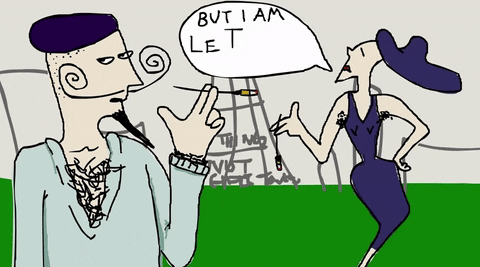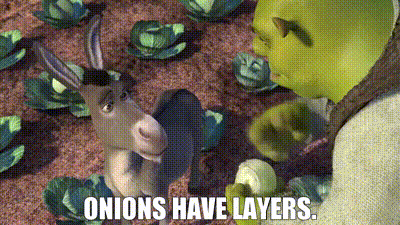The Bummers of Burn Out
Wading Through the Dangers of the Fire Swamp
But I Am Le Tired
I know we’re all familiar with the feeling of staring at our screen for what seems like hours to no avail. Your mind is absolutely blank, and you don’t want to do or make ANYTHING. It’s like a positivity parasite that creeps up when you think you’ve finally hit your stride. One moment you’re on fire, getting clients, cranking out designs, selling hella merch, and the next, you’re laid out on your couch, unable to summon even a spark of inspiration or drive.
Well, I spend a lot of time in a state of “burnout.” And I have throughout my life. As a teenager, it was diagnosed as clinical depression and anxiety. As an adult, it’s been diagnosed as ADHD and anxiety — and therefore neurodivergent burnout.
And honestly, the last month has been kind of a drag because I once again have burnt myself out, so let’s work through this together, yeah?
What’s Your Sign?
Let’s be clear: burnout is more than feeling tired. It's a full-body, mind-numbing exhaustion that seeps into your pores, creeps through your bloodstream, and leeches from your bones, leaving you a wholly drained husk. Life’s relentless cycle of dishes, laundry, groceries, cooking, exercising, and work, the constant pressure to grow and innovate, and the unending quest for perfection lead to that inevitable crash.
Chronic Fatigue: Deeper than a night out or an all-nighter to finish a project. Tired in your bones and exhausted in your soul.
Cynicism & Detachment: Everything’s a chore, even the shit you love. And that love? Gone. Replaced by apathy and dissociation.
Inefficiency: Things that used to take one hour now take three. And the quality is seriously lacking. You’re frustrated — you’re basically Anger from Inside Out.
But how the hell did you get here? Burnout doesn’t happen overnight. It’s a slow burn and not the good kind that happens in broody romantasy books full of Fae.
Maybe you bit off more than you can chew, taking on more projects than you can handle, because you’re a chronic people pleaser who forgets that they can say no. Perhaps it’s the perfectionism and your endless tweaking. It could even be your complete lack of boundaries. When your home becomes your office, work hours bleed into personal time, and suddenly, you’re working every day at all hours.
Why’s It Spicy?
Burnout can be even more tricky to navigate if you're neurospicy. Whether you're dealing with ADHD, autism, dyslexia, or another condition, your brain's wiring can add a whole mess of unique layers to the burnout experience. The sensory overload that stems from constant exposure to noise, bright screens, and clutter can be overwhelming, and it often leads to quicker burnout. Executive dysfunction is also common and causes problems with planning or starting tasks and can make deadlines feel insurmountable. Masking, or trying to fit into neurotypical norms, can drain energy reserves faster than usual as well.
The Climb
Here’s the thing - you likely didn’t come here just to learn if you’re burnt out. We’re all pretty consistently facing burnout right now, so you probably want some insight into how to fix it, right?
I wish I had a definitive answer for you, but I don’t. And I don’t have a cure or any simple mantra. All I have to offer you is my camaraderie and a list of some things that I make myself do when I hit the metaphorical wall.
Acceptance: You have to admit to yourself that you’re burnt out. No more pretending everything’s peachy keen. It’s totally normal to feel this way, I promise. Mainly because you’re not a robot.
Take a Break: If you can afford to take time off for this, that’s awesome, but most people can’t, so for the time being, step away from the computer. Take the day. Don’t scroll Instagram or think about your to-do list. Disconnect. Go for a walk, read a book, binge the show you’ve been saving, or take a nap. Recharge your batteries. (I just took four days off because my body made me with a migraine, so heed my warning).
Set Boundaries: Create work hours for yourself and STICK TO THEM. When work’s done, close your laptop or walk away from your desk. Keep a separate workspace if you’re working from home and have room - physical boundaries can help reinforce mental ones.
Self-Care: You are the most crucial person in your life. And burnout often stems from neglecting yourself. So exercise, eat well, get enough sleep, and don’t forget to indulge in the things that make you feel alive with the people who cheer you on. Self-care isn’t selfish; it is absolutely necessary.
Sensory-Friendly Space: Adjust lighting, reduce noise, and organize your workspace to minimize sensory overload.
Use Tools & Aids: There are tons of apps and planners designed to help manage tasks and deadlines more effectively. Notion is my personal favorite.
Take Micro-Breaks: Short, frequent breaks can help reset your focus and prevent sensory overload. Pomodoro for the win!
Rebuilding Momentum
The truly annoying thing about burnout as a creative is that it murders the muse. So once you’ve started to feel a bit better, it’s time to find your inspiration again. This part is real important because, without your spark, you’re likely to slide right back into burnout.
Take a Hike
Go New Places
Reflect & Reassess
Connect with Others
Make a Playlist & Dance
Experiment with a New Art Style
Taking Evasive Action
The primary goal going forward is to prevent burnout from happening again. So, creating sustainable habits and a balanced approach to work and life is also necessary (this is the part that I’m not very good at).
Set Realistic Goals: Progress, not perfection. Break projects into manageable tasks and set achievable deadlines.
Regular Breaks: Incorporate short breaks throughout your day. Walk around and stretch your legs. Remember to eat. Drink water.
Delegation: Don’t be afraid to ask for help. You don’t have to do everything alone.
Remember, every journey is different. Creativity is about exploration. Pace yourself, take care of yourself, and keep the fire alive. You’ve got this, and I’m proud of you.




